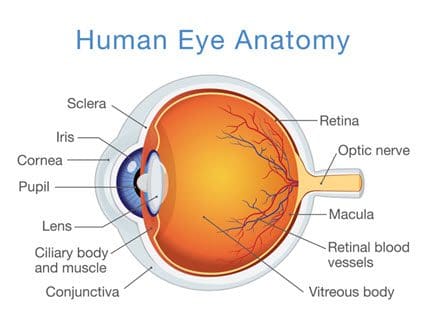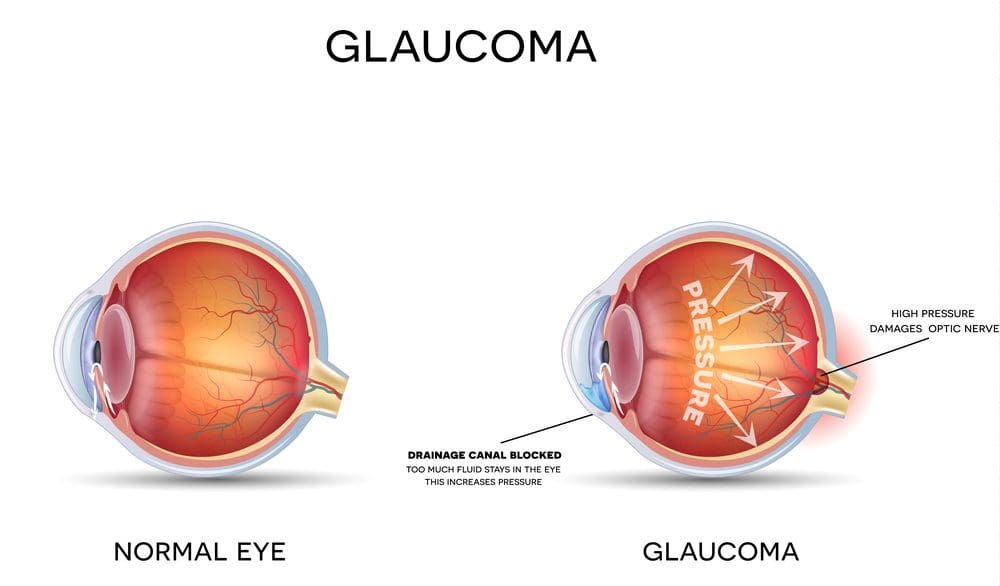How to Reverse or Fix Optic Nerve Cupping
Home / Vision Education Center /
Last Updated:
The optic nerve sits in the back of your eye, and it’s surrounded by a dense network of other nerve fibers. When those smaller nerves die, the space they leave behind looks a bit like a cup. Doctors call this “optic nerve cupping,” not to be confused with cosmetic eye cupping.
Table of Contents
Cupping can be a sign of glaucoma, and this condition always needs treatment. Without proper care, glaucoma can steal your vision.
But if you do not have glaucoma, your doctor may opt to observe your eyes and wait to intervene unless the problem gets worse.
Understand Eye Anatomy

Think of your optic nerve as an electrical cord, and think of your eye as an electrical socket. These two pieces connect tightly, so information flows freely. A mesh of nerves and fibers surrounds your optic nerve, so it’s always in the right spot. If that network dies, your doctor will see a cup-like space around your optic nerve in the back of your eye.
The Glaucoma Research Foundation says glaucoma is a common cause of optic cupping. When you have glaucoma, your eye is filled with an unusual amount of fluid, and it puts immense pressure on all the tissues in your eye. Nerves are delicate, and they can’t stand the pressure. They will die, and that leaves your optic nerve exposed.
You can’t see your optic nerve in a mirror, even if you open up your eyes as wide as you can. But your doctor can spot this problem with an ophthalmoscopy. For this test, you will:
You deserve clear vision. We can help.
With 135+ locations and over 2.5 million procedures performed, our board-certified eye surgeons deliver results you can trust.
Your journey to better vision starts here.
- Have your eyes dilated. Eye drops will ensure the backs of your eyes are visible to the doctor.
- Sit in a darkened room. When your pupils are dilated, bright lights are painful. Your doctor will lower the lamps in the room, so you are comfortable.
- Push your head back into the chair. You will need to hold still during the exam, and your headrest can make that happen.
- Hold your eyes open. Your doctor will use an ophthalmoscope to look at the back of your eye. The tool may have a light on it, and your doctor might ask you to look up, down, or to the side during the test.
At the end of this exam, your doctor will have an estimate of how big your cup is, and the doctor will know how big it should be. You might need more tests to determine why the problem is happening and what treatments might help, but this 10-minute test is a good place to start.

Does It Need Treatment?
Sometimes, optic cupping is the first glaucoma sign your doctor sees during an exam. A follow-up test of eye pressure can confirm the glaucoma diagnosis, and when that happens, you absolutely need treatment.
Rising eye pressure can damage your optic nerve irreparably, and that can lead to reduced or lost vision. You can’t get it back when it’s gone.
The Glaucoma Foundation says your treatment might include:
- Eye drops. Medications can reduce pressure inside your eye and keep tear ducts open. It’s crucial to use these drugs on a regular schedule, and you should tell your doctor if uncomfortable side effects like burning or stinging prevent you from using them.
- Oral medications. Pills can also reduce eye fluid production, but they come with more side effects than drops. Typically, you will take these drugs two to four times per day.
- Laser surgery. These procedures improve eye drainage, so fluid can move out of your eye rather than building up.
- Traditional surgery. Your doctor might place a drain tube in the eye or surgically remove tissue to reduce pressure.
Therapies like this can reduce cupping, say researchers writing for the American Academy of Ophthalmology. About half of patients who got glaucoma therapy had cup size decreased. But these patients still needed glaucoma care, and some still had vision loss.
After your cupping treatment, you will need to stay in touch with your doctor and follow your glaucoma treatment plan to preserve your vision.

Cupping Without Glaucoma
No one can see the back of your eyes (without tools, of course), so no one will know that you have cupping. Just as it does not cause cosmetic problems, cupping alone will not cause intense eye damage. Your doctor may not choose to treat it right away.
Cupping can increase your risk for glaucoma, says Glaucoma Today, and that means your doctor will want to check your eye health and pressure very frequently when the back of your eye looks unusual. If glaucoma is eventually discovered, you will need treatment right away.
But if your doctor never discovers glaucoma and the cups do not seem to get bigger with time, you may not need any kind of treatment.
Every eye is a little different, and it is not unusual for some people to have eyes that just do not look the same as others. There is no reason to fix something that is not causing you problems, and many eye surgeries come with risks you do not need to take on unnecessarily.
If your doctor has spotted cups, discuss what that means for your eye health and what should happen next. Keep all your eye exam appointments, and talk to your doctor often about what’s happening now and what it means for your future. Together you can come up with the right plan for your eyes, your vision, and your future.
You deserve clear vision. We can help.
With 135+ locations and over 2.5 million procedures performed, our board-certified eye surgeons deliver results you can trust.
Your journey to better vision starts here.
References
- Optic Nerve Cupping. (October 2017). Glaucoma Research Foundation.
- Ophthalmoscopy. (February 2017). U.S. National Library of Medicine.
- Deciding Between Glaucoma or Physiologic Cupping. (October 2014). Optometry Times.
- Treating Glaucoma. The Glaucoma Foundation.
- Cupping Reversal May Not Indicate Successful Treatment in Pediatric Glaucoma. (December 2014). American Academy of Ophthalmology.
- Evaluating and Managing Optic Disc Cupping in Children. (January 2009). Glaucoma Today.Evaluating and Managing Optic Disc Cupping in Children. (January 2009). Glaucoma Today.
This content is for informational purposes only. It may have been reviewed by a licensed physician, but is not intended to serve as a substitute for professional medical advice. Always consult your healthcare provider with any health concerns. For more, read our Privacy Policy and Editorial Policy.
